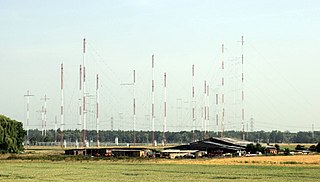
In antenna theory, a phased array usually means an electronically scanned array, a computer-controlled array of antennas which creates a beam of radio waves that can be electronically steered to point in different directions without moving the antennas. In an array antenna, the radio frequency current from the transmitter is fed to the individual antennas with the correct phase relationship so that the radio waves from the separate antennas add together to increase the radiation in a desired direction, while cancelling to suppress radiation in undesired directions. In a phased array, the power from the transmitter is fed to the antennas through devices called phase shifters, controlled by a computer system, which can alter the phase electronically, thus steering the beam of radio waves to a different direction. Since the array must consist of many small antennas to achieve high gain, phased arrays are mainly practical at the high frequency end of the radio spectrum, in the UHF and microwave bands, in which the antenna elements are conveniently small.

Shortwave radio is radio transmission using shortwave radio frequencies. There is no official definition of the band, but the range always includes all of the high frequency band (HF), and generally extends from 3–30 MHz ; above the medium frequency band (MF), to the end of the HF band.
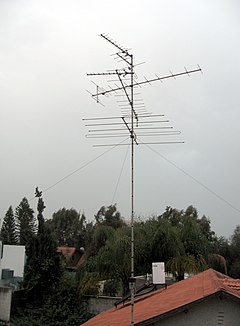
Very high frequency (VHF) is the ITU designation for the range of radio frequency electromagnetic waves from 30 to 300 megahertz (MHz), with corresponding wavelengths of ten meters to one meter. Frequencies immediately below VHF are denoted high frequency (HF), and the next higher frequencies are known as ultra high frequency (UHF).
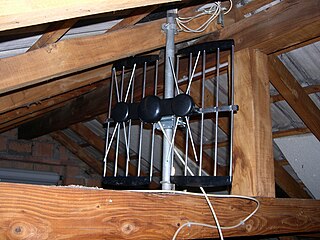
Ultra high frequency (UHF) is the ITU designation for radio frequencies in the range between 300 megahertz (MHz) and 3 gigahertz (GHz), also known as the decimetre band as the wavelengths range from one meter to one tenth of a meter. Radio waves with frequencies above the UHF band fall into the super-high frequency (SHF) or microwave frequency range. Lower frequency signals fall into the VHF or lower bands. UHF radio waves propagate mainly by line of sight; they are blocked by hills and large buildings although the transmission through building walls is strong enough for indoor reception. They are used for television broadcasting, cell phones, satellite communication including GPS, personal radio services including Wi-Fi and Bluetooth, walkie-talkies, cordless phones, and numerous other applications.

Medium frequency (MF) is the ITU designation for radio frequencies (RF) in the range of 300 kilohertz (kHz) to 3 megahertz (MHz). Part of this band is the medium wave (MW) AM broadcast band. The MF band is also known as the hectometer band as the wavelengths range from ten to one hectometer. Frequencies immediately below MF are denoted low frequency (LF), while the first band of higher frequencies is known as high frequency (HF). MF is mostly used for AM radio broadcasting, navigational radio beacons, maritime ship-to-shore communication, and transoceanic air traffic control.

High frequency (HF) is the ITU designation for the range of radio frequency electromagnetic waves between 3 to 30 megahertz (MHz). It is also known as the decameter band or decameter wave as its wavelengths range from one to ten decameters. Frequencies immediately below HF are denoted medium frequency (MF), while the next band of higher frequencies is known as the very high frequency (VHF) band. The HF band is a major part of the shortwave band of frequencies, so communication at these frequencies is often called shortwave radio. Because radio waves in this band can be reflected back to Earth by the ionosphere layer in the atmosphere – a method known as "skip" or "skywave" propagation – these frequencies are suitable for long-distance communication across intercontinental distances and for mountainous terrains which prevent line-of-sight communications. The band is used by international shortwave broadcasting stations (2.31–25.82 MHz), aviation communication, government time stations, weather stations, amateur radio and citizens band services, among other uses.
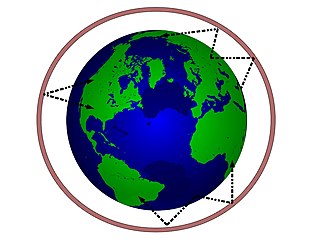
In radio communication, skywave or skip refers to the propagation of radio waves reflected or refracted back toward Earth from the ionosphere, an electrically charged layer of the upper atmosphere. Since it is not limited by the curvature of the Earth, skywave propagation can be used to communicate beyond the horizon, at intercontinental distances. It is mostly used in the shortwave frequency bands.
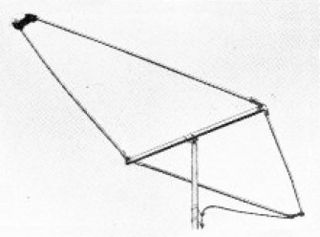
A rhombic antenna is made of four sections of wire suspended parallel to the ground in a diamond or "rhombus" shape. Each of the four sides is the same length – about a quarter-wavelength to one wavelength per section – converging but not touching at an angle of about 42° at the fed end and at the far end. The length is not critical, typically from one to two wavelengths (λ), but there is an optimum angle for any given length and frequency. A horizontal rhombic antenna radiates horizontally polarized radio waves at a low elevation angle off the pointy ends of the antenna.
Radio Netherlands Worldwide was a public radio and television network based in Hilversum, producing and transmitting programmes for international audiences outside the Netherlands. Radio Netherlands Worldwide also distributed content via web and e-mail technology from as early as 1992.
The 80 meter or 3.5 MHz band is a band of radio frequencies allocated for amateur radio use, from 3.5 to 4.0 MHz in IARU Region 2, and generally 3.5 to 3.8 or 3.9 MHz in Regions 1 and 3 respectively. The upper portion of the band, which is usually used for phone (voice), is sometimes referred to as 75 meters. In Europe, 75m is a shortwave broadcast band, with a number of national radio services operating between 3.9 & 4.0 MHz.
The 20-meter or 14-MHz amateur radio band is a portion of the shortwave radio spectrum, comprising frequencies stretching from 14.000 MHz to 14.350 MHz. The 20-meter band is widely considered among the best for long-distance communication (DXing), and is one of the most popular—and crowded—during contests. Several factors contribute to this, including the band's large size, the relatively small size of antennas tuned to it and its good potential for daytime DX operation even in unfavorable propagation conditions.

ALLISS is a fully rotatable antenna system for high power shortwave radio broadcasting in the 6 MHz to 26 MHz range. An ALLISS module is a self-contained shortwave relay station that is used for international broadcasting.
The National Radio and Television Administration (NRTA), formerly the State Administration of Radio, Film, and Television and the State Administration of Press, Publication, Radio, Film and Television, is a ministry-level executive agency directly under the State Council of the People's Republic of China. Its main task is the administration and supervision of state-owned enterprises engaged in the television and radio industries.

Shortwave relay stations are transmitter sites used by international broadcasters to extend their coverage to areas that cannot be reached easily from their home state. E.g., the BBC operates an extensive net of relay stations.
CKCX was the callsign used for the Canadian Broadcasting Corporation's shortwave transmitter complex near Sackville, New Brunswick at the Tantramar Marshes. The Sackville Relay Station was operated by Radio Canada International and broadcast its programming around the world as well as relay transmissions from several foreign shortwave broadcasters. Domestically, it transmitted broadcasts on 9.625 MHz to northern Quebec by CBC North, the James Bay Cree Communications Society and Taqramiut Nipingat, the Inuit communications society of the Nunavik region of northern Quebec. The CKCX designation was assigned after CBC Radio's CBA, under whose licence the Sackville complex originally operated, moved to Moncton in 1968. Sackville was also used by Radio Japan, China Radio International, Voice of Vietnam, BBC World Service, Deutsche Welle and Radio Korea as part of a transmitter time exchange agreement.

The Moxon antenna or 'Moxon Rectangle' is a simple and mechanically robust two-element parasitic array antenna. It takes its name from the amateur radio operator Les Moxon.
A shortwave broadband antenna is a radio antenna that can be used for transmission of any shortwave radio band from among the greater part of the shortwave radio spectrum, without requiring any band-by-band adjustment of the antenna. Generally speaking, there is no difficulty in building an adequate receiving antenna; the challenge is designing an antenna which can be used for transmission without an adjustable impedance matching network.

An antenna array is a set of multiple connected antennas which work together as a single antenna, to transmit or receive radio waves. The individual antennas are usually connected to a single receiver or transmitter by feedlines that feed the power to the elements in a specific phase relationship. The radio waves radiated by each individual antenna combine and superpose, adding together to enhance the power radiated in desired directions, and cancelling to reduce the power radiated in other directions. Similarly, when used for receiving, the separate radio frequency currents from the individual antennas combine in the receiver with the correct phase relationship to enhance signals received from the desired directions and cancel signals from undesired directions. More sophisticated array antennas may have multiple transmitter or receiver modules, each connected to a separate antenna element or group of elements.
In radio systems, many different antenna types are used with specialized properties for particular applications. Antennas can be classified in various ways. The list below groups together antennas under common operating principles, following the way antennas are classified in many engineering textbooks.
